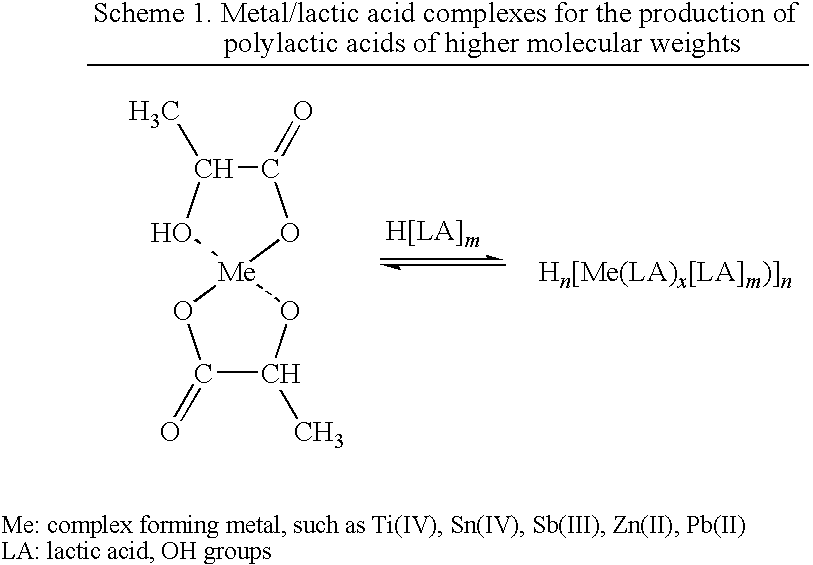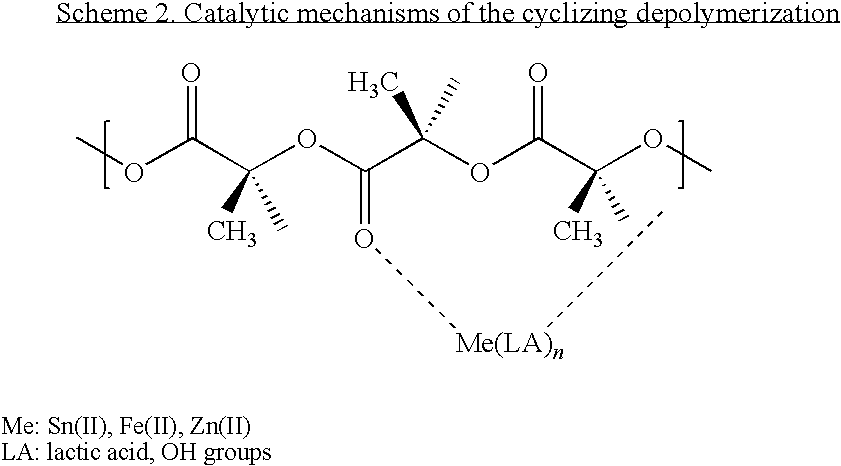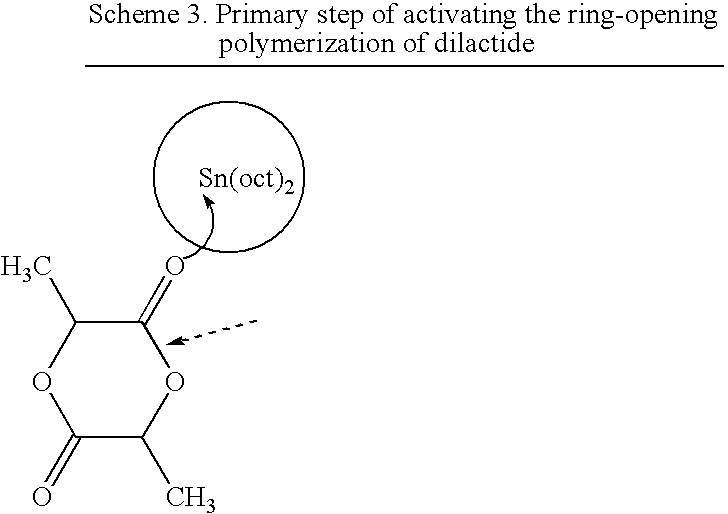Particulate catalyst and catalyst/stabilizer systems for producing high-molecular-weight homopolyesters and copolyesters of l-, d- or d,l-lactic acid
- Summary
- Abstract
- Description
- Claims
- Application Information
AI Technical Summary
Benefits of technology
Problems solved by technology
Method used
Image
Examples
example 1
[0067]For producing catalyst or stabilizer particles, solutions of catalysts or stabilizers in toluene, acetone, isopropanol or ethylene glycol are vigorously stirred with AEROSIL or AEROXID by means of a dispersion disc, followed by the evaporation of the solvent or dispersing agent under normal pressure or vacuum. With the very fine silica, mixed, or alumina of particle sizes <10 or <15 nm listed in Tables 9 and 10, the mass ratio of oxide to catalyst or stabilizer is varied between 1:1 and 4:1. With catalyst dosing as dispersion, redispersion is conducted by short-term mixing with an intensive agitator (Ultra-Turrax type) or in an ultrasonic bath.
TABLE 9Selected examples of nanoparticulate catalysts forthe production of poly-L-, -D- and -D,L-lactic acidsfrom L-, D- and D,L-lactic acids, respectivelyCatalystProcessexampleCarrier materialCatalystSolventstep1.1AEROSIL R 106KR 12toluenei)1.2- ″ -KR 38Stoluenei)1.3- ″ -DATtoluenei)1.4AEROSIL 300Tyzor LAisopropanoli)1.5- ″ -Tyzor LAace...
example 2
Polycondensation
[0068]1060 g of a 85% L-lactic acid (experimental product of the applicant) are completely dehydrated in a glass apparatus equipped with a stirrer, an external heater and a temperature-controlled Vigreux column in vacuum at 155° C. within 2 h, the vacuum being controlled so that no lactic acid is carried off via the distillate. After the dehydration phase, the temperature is increased to 185° C., and polycondensation is conducted for 4 h at 13 kPa with the addition of Catalyst 1.4 (dihydroxy-bis-(ammoniumlactato)-titanium Tyzor® LA / AEROSIL 300) (5 ml of dispersion with 10−4 mol of catalyst / mol of lactic acid). The yield, molar mass and [COOH] content of the polycondensation product are determined.
Yield: 700 g
[0069]Mn: 2,600 g / mol
[COOH]: 0.3 mmol / g
example 3
Polycondensation
[0070]900 g of an anhydrous L-lactic acid (experimental product of the applicant) are polycondensed for 3 h in a glass apparatus equipped with a stirrer, an external heater and a temperature-controlled Vigreux column in vacuum at temperatures of 150-210° C. in the presence of 5 g of Catalyst 1.2 (isopropyl-tri(dioctylphosphato)-titanate) (KR 38 S, AEROSIL R 106) (3*10−4 mol catalyst per mol lactic acid). The temperature and vacuum program is adjusted to not carry off any lactic acid via the distillate. The product is completely dehydrated in vacuum at 155° C. within 2 h. The final vacuum chosen is 13 kPa. By analogy with Example 2, the yield, molar mass and [COOH] content of the polycondensation product are determined.
Yield: 730 g
[0071]Mn: 3,600 g / mol
[COOH]: 0.3 mmol / g
PUM
| Property | Measurement | Unit |
|---|---|---|
| Nanoscale particle size | aaaaa | aaaaa |
| Particle diameter | aaaaa | aaaaa |
| Weight | aaaaa | aaaaa |
Abstract
Description
Claims
Application Information
 Login to View More
Login to View More - R&D
- Intellectual Property
- Life Sciences
- Materials
- Tech Scout
- Unparalleled Data Quality
- Higher Quality Content
- 60% Fewer Hallucinations
Browse by: Latest US Patents, China's latest patents, Technical Efficacy Thesaurus, Application Domain, Technology Topic, Popular Technical Reports.
© 2025 PatSnap. All rights reserved.Legal|Privacy policy|Modern Slavery Act Transparency Statement|Sitemap|About US| Contact US: help@patsnap.com



